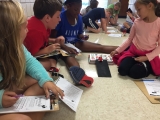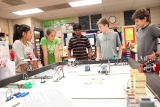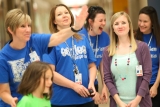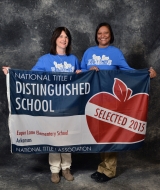-
Category 2
Selected in 2015
-
Grades: k - 6
School Setting: urban
Town Population: 85,000
Student Enrollment: 470
Student Demographics:
Black/African American: 9.6%
Teacher/Student Ratio: 1:25
White/Caucasian: 60%
Hispanic: 20.4%
Hawaiian/Pacific Islander: 0.2%
Asian: 4.9%
Native American: 1.1%
Other: 3.8%
% Reduced Lunch: 54.7%
% ELL Learners: 12%
Founded: 1986 -
PRINCIPAL:
Sherri Penix -
CONTACT:
6601 Euper Lane
Fort Smith, AR 72903
479-452-2601
spenix@fortsmithschools.org
Euper Lane Elementary School
Fort Smith, AR
TEAM- It truly does take a village to raise a child! We believe that all staff can participate in providing guidance and instruction to our children. It also means that in order for change to take place, we need to look at ourselves and be willing to reflect on what is best for students.
- Describe specific programs in place to ensure that families are involved in the success of your school and students.
- We have a very strong and active PTA which provides ample opportunities for parents and family members to participate in school events. We have two scheduled parent/teacher conferences (one in the fall and one in the spring) in which parents and teachers discuss student progress. We have various family oriented activities throughout the year that provides opportunities for families to be engaged. Examples are Take Your Family To School Week, STEM Night, Strong Fathers, Strong Families, Book Fair, Grandparents' Day, Read Across America, awards assemblies, Spelling Bee, Geography Bee, Cafecito, etc. Teachers communicate with parents via email, texts, phone, notes, Edmodo, Protopage, Class Dojo, etc. to keep them informed of upcoming classroom events, assignments and progress.
- Describe the most successful activity your school has initiated to strengthen ties to your community.
- This year our school implemented a program entitled "Strong Fathers, Strong Families". It is a year long initiative that involves time for parents (with a focus on fathers) to become more involved in their child's academic experiences. Research supports the program because students who have an active father or father figure in the home or the environment were likely to improve and experience academic success. We have witnessed that success at Euper Lane. We had an initial morning of Bring Your Dads to School where over 200 participants were involved and visiting classrooms. It was awesome to hear fathers ask questions and to participate in activities that can be used with their children. Our second day was a Reading Morning with the fathers and children. The last day will be a Science and STEM night which will be a part of our Take Your Family To School Week.
- Describe your philosophy of school change or improvement.
- TEAM- It truly does take a village to raise a child! We believe that all staff can participate in providing guidance and instruction to our children. It also means that in order for change to take place, we need to look at ourselves and be willing to reflect on what is best for students. We have to be willing to have the tough conversations about student learning and teaching. We must agree as a body of educators that we will do what is in the best interest of all students and that we are willing to do whatever it takes to make it happen. Change can be difficult and challenging but if what we are doing is not being effective, it is our duty to find a better way. Our children deserve the best that we can give them and nothing less.
- What are your school’s top two goals for the next year?
- Our first goal is to provide authentic and engaging instruction for students to help them improve on standardized testing in reading and math whether they are the struggling student or the high achieving student. Our second goal is to continue meeting in professional learning communities which will allow us to focus on student learning and teaching.
- What is the single most important factor in the success of your school that others could replicate?
- The single most important factor in the success of our school is building positive relationships. We have strong and positive relationships staff to staff, staff to student, staff to parent and school to community. It takes all stakeholders to be invested in the academic, personal and behavior goals and expectations of our school community/culture.
- Describe the program or initiative that has had the greatest positive effect on student achievement, including closing achievement or opportunity gaps, if applicable.
- Three years ago the instructional staff which is inclusive of the classroom teachers, interventionist, facilitators and support staff met in professional learning communities to discuss student achievement. We discussed why and how students were growing academically and if they were not, what were the reasons behind it. We looked at required standards and essential skills horizontally and vertically to analyze trends, strengths and weaknesses. This summer the School Leadership Team participated in a Rick DuFour PLC Conference and provided professional development for the entire staff in August 2015. We continue to meet in weekly, monthly and quarterly PLCs with a specific focus on student work to go deeper into understanding what are the individual student's needs. This information is used to guide and plan the appropriate instruction based on student need.
- Explain how Title I funds are used to support your improvement efforts.
- The Title I funds are allocated in several areas based on student and teacher need. Upon reflection and observation, teachers and administrators decide on specific materials such as professional books, classroom instructional tools, etc. that can be used during core instruction, small groups or targeted interventions. Teachers or administrators may participate in professional development opportunities such as conferences, workshops, and peer observations that allow them to grow professionally and utilize ideas for instruction. Funds are used to support and engage positive parental involvement. Our parent facilitator along with an active PTA provide information and opportunities for parents to be actively engaged in their child's academic and personal success.
- Identify the critical professional development activities you use to improve teaching and student learning.
- Teachers are required to look at their individual professional growth plans and engage in professional development opportunities that will allow them to become better at their craft. The most effective and substaining professional development is embedded and ongoing. A good example of that is our current Professional Learning Communities. We are learning about what that looks like for our instructional environment but it allows us to continue with an exchange of ideas and strategies that can be used with our students ultimately to improve teaching and student learning. The facilitators meet with teachers weekly to either plan lessons with them, talk about individual students and the needs, model classroom lessons or coteach and have reflective conversations.
- Describe how data is used to improve student achievement and inform decision making.
- Data definitely drives how we provide the most effective and appropriate instruction to our students. Our students are assessed in reading, math and writing at the beginning of the year to determine a baseline for instruction. That data is compared to any additional test results such as standardized testing to provide a beginning profile for each student. Teachers also utilize additional formative and perceptual assessment data to familiarize themselves with the students assigned to them. Teachers have access to each student's cumulative record and have professional conversations with previous teachers. Teachers, administrators and support staff meet weekly, monthly, and quarterly to discuss student work and progress. Every member of the instructional team has a voice and these exchanges lead to more specific and authentic instruction.
- Describe your school culture and explain changes you’ve taken to improve it.
- Our school mission statement is "Working Together Today To Be Compassionate And Honorable Leaders Of Tomorrow". This encompasses what we are about and what we want to instill in our students each and every day. Our students need to be prepared to live and work in an environment conducive to getting along with others, being problem solvers and being good citizens. We use every opportunity to teach and model this behavior through leadership activities in and around the school and classrooms. We begin each year with teaching our students Stephen Covey's 7 Habits of Highly Effective People. Teachers then develop with their students their classroom mission statements and expectations of academic and personal behavior. Teachers allow students to set goals for each area. Students then evaluate periodically where they are to see if they are on track with their goals. At the beginning of each year the staff revisits the mission and vision to reflect on what is working and what is not.
Stats
-
Category 2
Selected in 2015
-
Grades: k - 6
School Setting: urban
Town Population: 85,000
Student Enrollment: 470
Student Demographics:
Black/African American: 9.6%
Teacher/Student Ratio: 1:25
White/Caucasian: 60%
Hispanic: 20.4%
Hawaiian/Pacific Islander: 0.2%
Asian: 4.9%
Native American: 1.1%
Other: 3.8%
% Reduced Lunch: 54.7%
% ELL Learners: 12%
Founded: 1986 -
PRINCIPAL:
Sherri Penix -
CONTACT:
6601 Euper Lane
Fort Smith, AR 72903
479-452-2601
spenix@fortsmithschools.org










